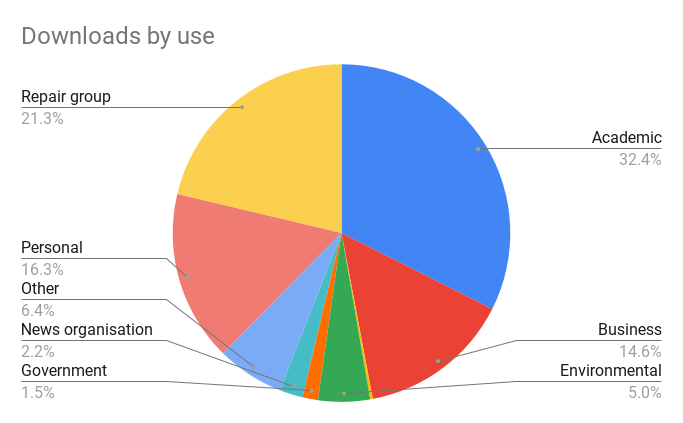We are very pleased to announce the release of our latest set of Open Repair Data. The Open Repair Alliance dataset now contains over 130,000 repair attempts logged at community repair events around the world.
Read on to find out more about the data and how it is used – and download the data for yourself!
What’s new with the data?
As always, you can see an overview of the repair data on our Insights page, and view the full dashboard here. We’ve updated the dashboard for this release to include filters on product category, country, and event date, so you can drill down further into the data.
Growth of data from groups around the world
The ORA data contains records of repair attempts from over 13,000 community repair events, held by over 800 repair groups, across 30 countries. That’s huge!
We’ve jumped from 649 to 873 groups in the 6 months since the previous aggregation. This is partially attributable to Repair Cafe Denmark providing individual group names this year, but for all networks we can see an increase in groups logging data. And in this release we have added data logged from three new countries: Uganda 🇺🇬, Korea 🇰🇷, and Iceland 🇮🇸.
The rate at which repair data is being logged continues to increase, with 2023 to September already having more items logged than 2022. In the six months since our previous aggregation, 30,350 new repair attempts have been logged. That’s more in six months than was contained in our very first set of data released in 2019 🤯
Types of products
The top 5 product categories logged in the data are: vacuums, lamps, Hi-Fi separates, coffee makers, and power tools. This is mostly stable since our last release – the only change being laptops slipping below coffee makers and power tools.
The categories with the highest successful repair rates are: sewing machines, lamps, hair dryers, decorative and safety lights, and paper shredders. This is again stable since our last release, with just decorative and saftely lights and paper shredders swapping places.
The lowest successful repair rates at events go to: DSLR/video cameras; flat screens; digital compact cameras; printer/scanners; and aircon/dehumidifiers. The only change here is aircon/dehumidifiers entering the hall of shame, taking the place of TV and gaming-related accessories.
Wondering what constitutes the different categories? Take a look here in the standard.
What is being done with the data?
Volume of data alone doesn’t make a difference. To help make the case for more repairable products, improved support and access to better repair services, the raw data needs to be analysed and reported on. From right to repair policy consultations, to campaigning and activism, to journalism, to individuals simply learning how to do data science, the Open Reliance Alliance data has been used widely.
Citizen science and campaigning
Over the years we have run multiple citizen science projects on the ORA data, using it to determine common fault types of key product categories. We’ve looked at mobiles, printers, tablets, batteries, laptops and vacuum cleaners. Insights from these analyses have been used by the European Right to Repair campaign to make the case for spare parts and repair information to be made widely available. You can find out more on our Insights page.
Uses of the data in the wild
Since 2020, we’ve seen over 900 downloads of the data, with a wide variety of uses by organisations and individuals. From repair groups, to environmental agencies, to device manufacturers and news organisations, to individuals, it’s gratifying to see the data in use. Our data is even part of a course on Codeacademy to help students learn data science!
Check out our Insights page for a number of public reports by partners that make use of the Open Repair Alliance data.

We ask downloaders to leave a comment when downloading the data. There are many interesting use cases, with just a small sample picked out below:
Researchers, journalists and others

Students

What could you use it for? Download it now!
What’s next?
Now that the Open Repair Alliance dataset is well established, with a significant quantity of records, we will be focusing our efforts more on improving data quality and extending our analysis and reporting with the data. As such, we’ll switch to a yearly release of the raw data itself. We plan for the next release to coincide with Repair Day 2024, which this year is taking place on 9th October 2024, and we aim to publish a full report based on the ORA data alongside the release.
Additionally, to make the ORA data more immediately usable by researchers, we are investigating updating the Open Repair Data Standard to include a set of product categorisations of electrical and electronic equipment produced by United Nations University, called the UNU-KEYs. These are widely used in e-waste research. We would love to partner with others on this work, so if you’re interested, please get in touch.